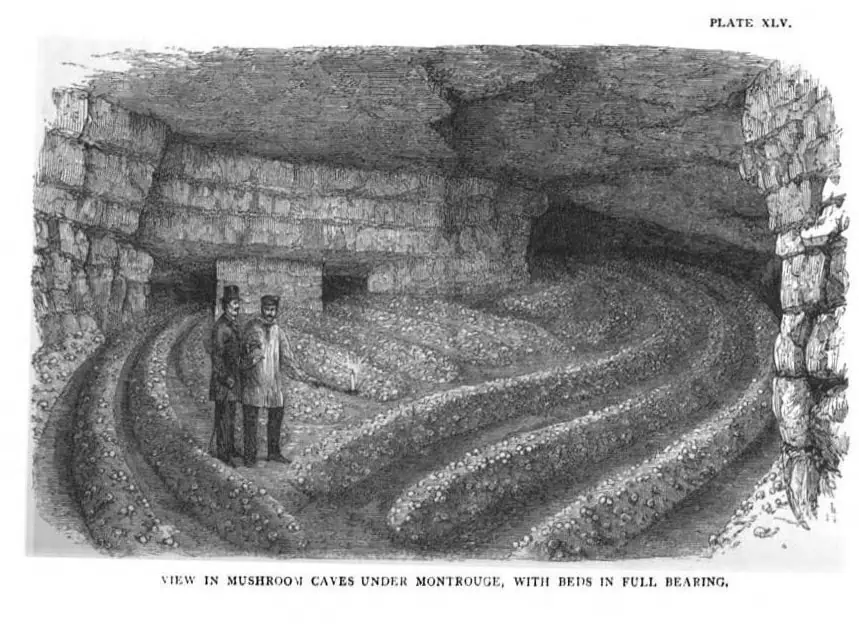Menu
Learn
Our Functional Food
Mushroom SupplementsMushroom CoffeeHealth BenefitsMushroom RecipesGrowing Mushrooms
New? Start here!Mushroom Growing: Help For CustomersNews & Media
NewsThis is probably the number one question people ask. The short answer is NO! … ironically the very fungi that people often think of as “growing in the dark” are the button varieties, also often called field mushrooms… for a reason! Will come back to that in a minute.
I blame the French for making people think that mushrooms grow in darkness. Because, it was French horticulturalists, in the mid-17th century, that perfected the mass cultivation of these fungi in caves, abandoned quarries, and most famously in the catacombs under Paris.
It was these stable humid and warm conditions (think fetid) that allowed them to mature quickly, rather than the lack of light (which they did not need). This allowed for intensive cultivation year-round, and the ability to feed a quickly expanding city.

Indeed, fungi s don’t need light (like a plant) to survive. However, light does give them some of their nutritional value. For instance, they can convert ultraviolet light into vitamin D much like our skin can.
For many field mushrooms, this ability to grow in the dark means they can be very active at night. Not due to lack of light, but the dip in temperature causing the humidity (the water trapped as a vapour in the air) to condense, forming a dew on the cap. As this water later evaporates, the mushroom is able to pull water out of the ground due to the capillary action of this evaporation. The mushrooms own growth is largely from this water it is now able to pull from its mycelial roots.
Some varieties of mushrooms will prevent trees from growing, while others will even kill trees. This then creates a natural clearings in the forest. In essence, these organisms are partly responsible for creating the fields, for which field varieties are named. This open clearing is also where the dew will form at night.
Specific types of mushrooms have a deep & close relationship with specific plants, with which they have established an evolutionary partnership. In the case of these ‘field’ varieties, it is with the grasses and pasture. Other mushrooms like King Stropharia (or wine cap) have an association with fallen leaves and in breaking down mulch, or Oyster mushrooms, and Shiitake in decomposing a still-standing but dead tree.
If some types of fungi can kill trees, others types have more a more friendly relationship. For instance, the famous mycorrhizal fungi, which grow with the roots of the tree to create an interconnected network amongst the trees’ root system. This network of mushroom filaments will protect the trees and in some cases allow trees to communicate with each other, or pass on the nutrients from a mother tree to her baby sapling. This activity is often described as the wood-wide web.
These clearings allow pasture to grow and ruminant animals to graze. Then, when the animal drops its waste, new mushrooms may grow through it and spore. The mycelial action, of the newly growing mushroom, plus other microbes will quickly break down the waste to create soil. So, field varieties are very much part of the ecosystem that creates and maintains healthy pastures. After asking the grow-in-the-dark question, many people will go on to comment “Oh yeah, as a kid I remember seeing heaps of these mushrooms sprouting from out in the cow paddock”.
At OGM! we cultivate tree-growing types of mushrooms. In nature, these would live in the deep shade of a forest. So, we use blue spectrum light in our grow rooms as this is the wavelength that penetrates more deeply onto the forest floor. The reason this light is bluer is because much of the red spectrum light has been absorbed by leaves, and why the leaves appear green. With the red absorbed it reflects the yellow and blue spectrum light, which is why, to our eyes, leaves appear green. Because field mushrooms grow under an open sky, they will also respond well to red light.
In closing: there is a reason that field mushrooms are not called ‘cave organisms’. Although they are perfectly happy growing in one, they would never naturally grow there.